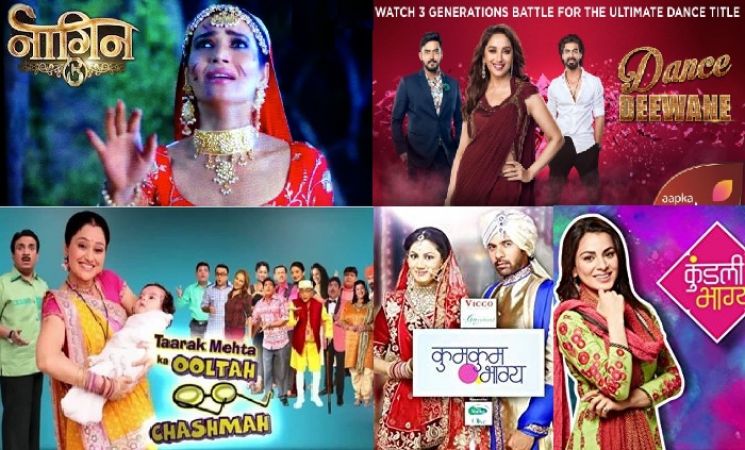Trap of TRPs : Data of Just A Select Few Households Are Extrapolated To Entire Nation ?
Published On: 21 May 2019 | Bollywood | By: Ravi Mondeti
TRP/BARC ratings for Week 19 (May 4-May 10, 2019) are out. yet again the same old daily soaps have topped the list, ones that are terribly made fun of on social media, the ones no one says proudly that He/She watches (at least in metro culture) and yet they top the list. Ever Wondered how TRP is calculated and why is it trusted despite the flaws?


Top 10 Indian TV Serials of May 2019 by BARC TRP Rating
- Kundali Bhagya
- Tarak Mehta Ka Ooltah Chashma
- Naagin 3
- Yeh Rishta Kya Kehlata Hai
- Kumkum Bhagya
- Shakti-Astitva Ek Ehsaas Ki
- Tujhse Hai Raabta
- Radhakrishna
- Kulfi Kumar Bajewala
- Kasauti Zindagi Ki 2
TRP is Target Rating points or commonly referred in the context of television as Television Rating Point, It is the tool that tells us which channel and the programme are viewed most or it indicates the popularity of a TV channel or a programme. Indian television itself has a viewer base of approx. 836 million and is constantly increasing and yet we cannot accurately say what the nation actually wants to watch. what we end up is a bunch of surveys on a sample space of fewer than 30 thousand, called TRPs. Which decide the fate of advertisements market which is expected to reach ₹ 91,742 crores by 2021, from ₹ 62,699.3 crores in 2018.
Brief History
Earlier, TRP was calculated by agencies namely INTAM and DART. DART that is Doordarshan Audience Research Team was used to calculate these ratings as that time the only channel available was only Doordarshan. Still, DART exists and is an agency which takes the TV viewing pattern of rural people into consideration. They randomly pick people and question them about the various channels and TV programmes and also use electronic methods to get viewership statistics.
INTAM (Indian Television Audience Measurement) or TAM India, a 50:50 joint venture between Nielsen and Kantar Media, was then responsible for the ratings that decide the fate of spending on TV advertising. It enjoyed a virtual monopoly, but its job left a lot to be desired.TAM was unable to capture ‘What India Watches’. The Indian TV industry had time and again said the number of TAM ‘people meters’, the boxes that collect the viewership data, were inadequate to cover the vast footprint of India. It was another matter that the industry was also not interested in investing in the expansion of TAM panel homes. Not only were questions raised on the credibility of TAM data, but charges of corruption were also being levelled against the agency.
The then UPA government decided to act. It asked Trai — India does not have a broadcast regulator — to come up with the guidelines for TV rating agencies. On September 11, 2013, Trai made public the guidelines after a lengthy consultation process. a few days after theTrai created guidelines for TV rating agencies, a meeting was underway in London. One of the people who attended the meeting was a senior Indian media professional who was closely associated with a key committee created by Broadcast Audience Research Council (BARC), a joint industry body of broadcasters, advertisers and advertising agencies. BARC was being propelled as an alternate TV viewership measurement system to the incumbent, TAM Media Research. In London, the media professional was exploring the possibility of taking Kantar on board. The aim was to get both Nielsen and Kantar, research consultancies, on board as vendors for research, planning, designing etc. Nielsen was willing to be a part of the new system but as part of the JV agreement with Kantar, it could not have entered the Indian market on its own. “You Indians can never do it”, the global head of Kantar Media, bluntly told the media professional, referring to BARC’s ability to create a TV rating system.
in April 2015 — before BARC would finally launch the first set of data. Later, individual ratings were launched and things started moving rapidly. Around the same time, clients began to terminate their contracts with TAM. The agency put on a brave face, publishing data despite few takers. But funding had dried up. “In hindsight, it was funny,” said another person with direct knowledge of the developments. “They (Kantar) went from denial — that BARC will never happen — to anger. Finally, it was decided that Kantar and Nielsen would join as junior partners of a company that will supply raw data to BARC.TAM meters would be redeployed as per BARC’s sample design and the meter management company will supply the raw data to BARC. According to a statement issued by BARC and TAM, a JV was formed, with BARC holding 51% stake along with full management control while the remaining 49% split equally with TAM’s owners – Kantar and Nielsen. The JV was later named Meterology Data Pvt Ltd. Effectively, it made BARC India the single provider of TV viewership data. Though there was still confused because of the presence of two different agencies, it ended with the exit of TAM from the TV viewership measurement business on February 29, 2016.
BARC - How TRP is calculated though?
- Audio Watermarking embeds audio watermarks in video content prior to upload and broadcast
- These watermarks are not audible to the human ear, but can easily be detected and decoded using dedicated hardware or software.
- The watermark is broadcast along with the content.
- As viewing details are recorded by the BAR-O-meters, so are the watermarks.
- The raw data is cleaned, merged with the channel, program, language and broadcast schedule details. Universe Estimates are applied to get viewership data.
This gives content owners unprecedented visibility into when and where their content is broadcast, who has viewed it, etc. As the watermark is part of the content, any attempt to destroy or remove it will also ruin the quality of the material in which it is embedded. This increases the integrity of the data generated by BARC India’s ratings. (Source)

Data of Just A Select Few Households Are Extrapolated To Entire Nation?
Yes and hence we don't see robustness in the feedback received by TV channels and so do we receive sloppily content. This is the major difference between TV and Web platforms, the latter empowers the consumers. In web platforms, the feedback is fast through likes and comments which keeps the content creators on Toes producing good content. Whereas in TV gathering data is the utmost challenge and added the corruption and manipulation, rotten the content further folds and viewers have no choice except to watch or Turn-off TV.
Tags: tv serials indian shows TRP
Meet the author
Cinephile and an aspiring Storyteller. Sharing my views and experiences (before and after watching a Movie) in this Space. Believes in Alfred Hitchcoc's principle of three things that can make a Great Movie - The Script ,The Script and The Script.







